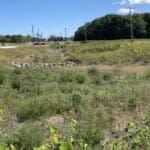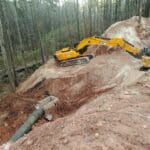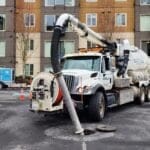City of Grand Forks
Grand Forks Stormwater Laws and Regulations
City of Grand Forks regulations are compliant with its North Dakota NPDES permit requirements for the city’s small municipal separate storm sewer system (MS4).
“The City of Grand Forks is currently authorized under permit number NDR04-0000 effective on April 1, 2016 and expiring March 31, 2021 to discharge stormwater to the Red River of the North as long as permit requirements are met.”
Excerpt- Stormwater Management Standards and Design Manual (2013)
The City of Grand Forks Stormwater Management Ordinance requires the development of Stormwater Management Plans for most development and land disturbing activities within the City and its extraterritorial jurisdiction. Grand Forks has three stormwater compliance standards that must be met and form the basis of the City’s regulatory and review criteria, they are:
- The First compliance standard that must be met is the requirements of the North Dakota Pollutant Discharge Elimination System Permit. The focus of this document is primarily on the quality of stormwater runoff and is regulated by the state of North Dakota.
- The second compliance standard is the Letter of Map Revision (LOMR) issued by the Federal Emergency Management Agency (FEMA) and received by the City in August 2007. TheLetter of Map Revision is based on the 2007 Flood Insurance Rate Study performed by the Corp of Engineers and primarily focuses on the quantity of stormwater runoff and water surface profiles of certain drainage conveyances. Development that potentially increases the quantity of stormwater runoff may raise water surface profiles, jeopardize the Letter of Map Revision and negatively impact the flood risk to the community.
- The third compliance standard is Chapter 15 of the Grand Forks City Code.
Excerpt- Grand Forks City Code
Article 9 stormwater management
(4) Stormwater management criteria for permanent facilitates. Stormwater control facilities included as part of the final design for a permanent development shall be addressed in the stormwater management plan and shall meet the following criteria:
- Pre versus post hydrological response of site. An applicant shall install or construct, on or for the proposed land-disturbing activity or development activity, all stormwater management facilities necessary to manage runoff such that increases in flow under the design conditions will not occur that could exceed the capacity of the outlet, or the stormwater management system, into which the site discharges or that would cause the stormwater management system to be overloaded or accelerate channel erosion as a result of the proposed land-disturbing activity or development activity. Under no circumstances shall the two-, ten-, or one-hundred-year developed peak flow exceed the two-, ten-, or one-hundred-year existing peak flow without prior written approval by the city engineer or unless attenuated by an approved off-site facility. For regional detention or stormwater management system, the city engineer shall recommend a proposed system charge or assessment to be approved by the city council based upon an approved watershed master plan and an analysis of required drainage systems, projected costs and flood protection benefits provided to those properties directly or indirectly impacted by the regional detention or stormwater management system.
- Natural features of the site. The applicant shall give consideration to reducing the need for stormwater management system facilities by incorporating the use of natural topography and land cover such as wetlands, ponds, natural swales and depressions as they exist before development to the degree that they can accommodate the additional water flow without compromising the integrity or quality of these natural features.
- Stormwater management strategies. The following stormwater management practices shall be investigated when developing a stormwater management plan:
- Natural infiltration of precipitation and runoff on site, if suitable soil profiles can be created during site grading. The purpose of this strategy is to encourage the development of a stormwater management plan that encourages natural infiltration. This includes providing as much natural or vegetated area on the site as possible, minimizing impervious surfaces, and directing runoff to vegetated areas rather than onto adjoining streets, storm sewers and ditches;
- Flow attenuation by use of open vegetated swales and natural depressions;
- Stormwater detention facilities; and
- Stormwater retention facilities (on a case-by-case basis).
- Other facilities requested by the city engineer.
- A combination of successive practices may be used to achieve the applicable minimum control requirements specified. Justification shall be provided by the applicant for the method selected.
- Adequacy of outlets. The adequacy of any outlet used as a discharge point for proposed stormwater management system must be assessed and documented to the satisfaction of the city engineer. To the extent practicable, hydraulic capacities of downstream natural channels, storm sewer systems, or streets shall be evaluated to determine if they have sufficient conveyance capacity to receive and accommodate postdevelopment runoff discharges and volumes without causing increased property damages or any increase in the established base flood elevation. If a floodplain or floodway has not been established by the Federal Emergency Management Agency, the applicant shall provide a documented analysis and estimate of the base flood elevation as certified by a professional engineer registered in the state. In addition, projected velocities in downstream natural or manmade channels shall not exceed that which is reasonably anticipated to cause erosion unless protective measures acceptable to the city engineer are approved and installed as part of the stormwater management plan. The assessment of outlet adequacy shall be included in the stormwater management plan.
- Stormwater detention/retention facilities. Stormwater detention or retention facilities proposed to be constructed in the stormwater management plan shall be designed according to the most current technology as reflected in the manual.
- Stormwater quality. The applicant shall provide sufficient analysis to demonstrate compliance with the applicable NPDES operations permit.
(5) Operation, maintenance and inspection. All stormwater management systems shall be designed to minimize the need for maintenance, to provide easy vehicle (typically eight (8) feet or wider) and personnel access for maintenance purposes, and to be structurally sound. All stormwater management systems shall have a plan of operation and maintenance that assures continued effective removal of pollutants carried in stormwater runoff. The city engineer may inspect all public and private stormwater management systems at any time. Inspection records will be kept on file at the city engineer’s office. It shall be the responsibility of the applicant to obtain any necessary easements or other property interests to allow access to the stormwater management system for inspection and maintenance purposes. The city engineer shall retain enforcement powers for assuring adequate operation and maintenance activities through permit conditions, penalties, noncompliance orders and fees.
15-0907. – Violations and enforcement.
(1) Responsibility for enforcement. The city engineer is authorized to enforce this article.
(2) Violations. Any failure to comply with the requirements of this article shall be considered a violation, subject to the remedies and penalties provided in this article. Violation shall include, but not be limited to, the following:
a. Land-disturbing activity without required permit or approval. No person shall initiate within the city any land-development activity, land-disturbing activity, or other activity resulting in an increase in stormwater quantities, degradation of stormwater quality, or restriction of flow in any storm sewer system, open ditch or natural channel, stormwater easement, water body, or wetland outlet, without having first complied with the terms of this article.
b. Authorities inconsistent with requirements. No person shall engage in land-disturbing activities on an owner’s land in contravention of the plans set forth in an approved SWPPP, an erosion and sediment control permit, any conditions for such plan or permit, any provision of this article or any other term, condition, or qualification imposed by city engineer, or other decision-making body, imposed or stated as part of a permit, certificate, or other form of authorization. This section applies to all persons including owners, their contractors and any utility companies or their contractors engaging in land disturbing activities.
c. Permanent facilities inconsistent with requirements. It is a violation of this article to erect, construct, reconstruct, remodel, alter, maintain, move, or use any permanent stormwater management or control facility in violation or contravention of this Article or of an approved plan as provided in this article.
d. Removal of tracked sediments and debris. The owner shall remove all sediments transported or tracked from owner’s land onto sidewalks, driveways and streets, whether public or private, by vehicles or construction traffic before the end of the each work day and failure to do so shall be a violation of this article.
e. [Additional requirements.] As to construction activities on owner’s land, the owner shall comply with the requirements of the erosion and sediment control permit, and with the following, and failure to do so shall be a violation of this article:
- Site dewatering. Water pumped from the site shall be treated by temporary sedimentation basins, grit chambers, sand filters, up-flow chambers, hydro-cyclones, soil concentrators, sediment bags or other appropriate controls as approved by the city engineer. Water may not be discharged in a manner that causes erosion, sedimentation, or flooding on the site, on downstream properties, in the receiving channels, or in any wetland.
- Waste and material disposal. All waste and unused building materials (including garbage, debris, cleaning wastes, wastewater, petroleum-based products, paints, concrete or concrete wash water, toxic materials, or other hazardous materials) shall be properly disposed of off site and shall not be allowed to be carried by runoff into a receiving channel, storm sewer system, or wetland.
- Tracking management. The use of clay or other cohesive soils to construct access roads or ramps over curbs or onto paved streets shall not be allowed.
- Water quality protection. The construction contractor, including the general contractor and all subcontractors, shall be required to control oil and fuel spills and chemical discharges to prevent such spills or discharges from entering any watercourse, sump, sewer system, water body, or wetland.
f. One- or two-dwelling-unit building. Construction of a one- or two-dwelling-unit building must comply with in-place BMPs and any existing permitted SWPPP for the subdivision, including NPDES permit requirements and failure to do so shall be a violation of this article.
g. Utility service lines. Utility companies or contractors working in a street right-of-way to repair existing or install new utilities that involve land disturbing activities shall obtain an excavation permit from the city engineer, in accordance with chapter XVI of the Grand Forks Municipal Code. With respect to utility companies that are working in a street right-of-way and are engaging in land disturbing activities, in addition to the requirements of chapter XVI, including the obligation of obtaining an excavation permit, the excavation permittee shall implement stormwater protection measures and utilize construction methods to minimize the potential for sediment or other contaminants to enter the city’s storm sewer system. The utility company or contractor shall provide street sweeping as necessary to prevent sediments from their activities from entering the storm sewer system. All sediments or other materials shall be removed from the site within one (1) working day of completion of utility installation on the site. All disturbed vegetation shall be replaced with seed or sod within seven (7) days of completion of utility installation on the site or other appropriate means of erosion and sediment control shall be implemented and maintained until the restoration is complete. All seeded or sodded areas shall be maintained by the utility company or contractor until vegetation is established except in the case of a utility repair for a private residence. For utility repairs to private residences the homeowner shall be responsible for the maintenance of vegetation until it is established. The contractor shall provide the homeowner with a “sediment and erosion control for new homeowners” fact sheet from the North Dakota State Health Department. The city will make available guidelines for acceptable temporary protection BMPs until the requirements for final stabilization are met.
(3) Management of site vegetation. Any landowner shall provide for the installation and maintenance of vegetation on their property in accordance with the following criteria, regardless as to whether or not a stormwater management plan, or erosion and sediment control permit has been approved or is necessary under this article. Failure to do so shall be a violation of this article:
a. Use of impervious surfaces. No person shall apply items included in the definition of “prohibited discharge” on impervious surfaces or within stormwater drainage systems with impervious liners or conduits.
b. Unimproved land areas. Except for driveways, sidewalks, patios, areas occupied by structures, landscaped areas, or areas that have been otherwise improved, all areas shall be covered by plants or vegetative growth. All land used for agriculture activates shall be exempt.
c. Use of pervious surfaces. No person shall deposit grass clippings, leaves, or other vegetative materials, with the exception of normal mowing or weed control, within natural or manmade watercourses, wetlands, or within wetland buffer areas. No person shall deposit items included in the definition of “prohibited discharge” except as noted above.
(2) Enforcement procedures. The following enforcement procedures shall apply to violations of this article:
a. Emergency suspension. In the case of violations of this article that do constitute an emergency situation, the city shall use all remedies, penalties and enforcement powers available under this article without prior notice, the city engineer must send notice with beginning enforcement action to the property owner and the permit holder as to the emergency actions taken.
b. Nonemergency. In the case of violations of this article that do not constitute an emergence, the city engineer may use any remedies, penalties and enforcement powers available under this article to bring the project back into compliance.
c. Notification. Whenever the city engineer finds that any person has violated or is violating this article, stormwater management plan, erosion and sediment control permit, and/or its conditions, or any prohibition, limitation or requirement contained herein, the city engineer shall serve upon such person a written notice stating the nature of the violation. Within seven (7) days of the date of the notice, unless a shorter time frame is set by the city engineer due to the nature of the violation, a plan satisfactory to the engineer for correction thereof must be submitted to the city engineer. If a satisfactory plan is not submitted in a timely manner, or the terms of such plan are not followed, the city engineer may order all work in the affected area to cease until submittal of such a plan and compliance with the plan is happening. If a person disagrees with the determination of the city engineer, that person, within fifteen (15) days of the order of the city engineer, may appeal the decision to the city administrator.
d. Appeal. If a person requests an appeal to contest the order of the city engineer, a written request for appeal shall be submitted to the city administrator. The city administrator will set a time and location to hear the appeal. If a future appeal is requested, the issue would be brought to the city council for review and decision.
e. Legal action.
- The discharge of deposited or eroded materials onto public rights-of-way or public storm sewer systems within the city shall be considered a public nuisance and a violation of this article and may result, in addition to other remedies, in an order to remove such materials. Removal of such materials shall be at the landowner’s and/or permittee’s expense based on the properties from which they originated. The landowner and/or permittee shall have three (3) days after receiving the notice to remove these materials. If the situation is determined to be an emergency by the city engineer, the three (3) days’ notice shall be suspended. Action and notification will be made as soon as practical. If such materials are not removed, others may remove them under the city engineer’s direction and any associated costs shall be the responsibility of the landowner or permittee and, if unpaid within 90 days, may be recommended for assessment action by the city council against property of the violator.
- If any person commences any land-disturbing activities which result in increased stormwater quantity or stormwater quality degradation into the city’s stormwater management system contrary to the provisions of this article, federal or state requirements or any order of the city engineer, the city attorney may, commence action for appropriate legal and/or equitable relief including administrative or criminal penalties.
(3) Remedies and enforcement powers. The city shall have the following remedies and enforcement powers:
a. Withhold permits. The city may deny or withhold all permits, certificates or other forms of authorization as to any applicant for a permit. Instead of withholding or denying an authorization, the city may grant such authorization subject to the condition that the violation be corrected. This enforcement provision applies regardless of whether the current owner or applicant is responsible for the violation in question. The city may deny or withhold all permits, certificates or other forms of authorization on any land or structure or improvements owned by a person who owns, developed or otherwise caused an uncorrected violation of a provision of this article or of a condition or qualification of a permit, certificate, approval or other authorization previously granted by a decision-making body. This provision applies regardless of whether the property for which the permit or other approval is sought is the property in violation.
b. Revocation of permits. A permit may be revoked when the city engineer determines that:
- There is departure from the plans, specifications, or conditions as required under terms of a permit or approved plan;
- The plans, specifications, or conditions were obtained by false representation or was issued by mistake; or
- Any of the provisions of this article are being violated as to the project under the permit.
c. Stop work order. When a violation of this article involves a failure to comply with approved plans or conditions to which the approval of such plans was made subject, the city engineer may issue a stop work order which will remain in effect until corrective action is taken.
d. Injunctive relief. The city may seek an injunction or other equitable relief in court to stop any violation of this article or of a permit, certificate or other form of authorization granted hereunder.
e. Abatement. The city may seek a court order in the nature of mandamus, abatement, injunction or other action or proceeding to abate or remove a violation or to otherwise restore the premises in question to the condition in which they existed prior to the violation.
f. Restitution. The city may seek an order requiring restitution as a condition to be met by a person before the person’s permit is restored, before the person is allowed to lawfully discharge into the sewer system, or before other action may be taken by the person as determined by an appropriate order.
g. Costs of damage. Any person violating any of the provisions of this article or who initiates an activity causes a deposit, obstruction, or damage or other impairment to the city’s stormwater management system is liable to the city for any expense, loss, or damage caused by the violation or the discharge. The city may bill the person violating this article the costs of any cleaning, repair or replacement work caused by the violation of stormwater discharge, and if unpaid within ninety (90) days may result in assessment of such costs against the violator’s property.
h. City attorney’s fees and costs. In addition to the fees and penalties provided herein, the city may recover reasonable attorney’s fees, court costs, court reporter’s fees, and other expenses of litigation by appropriate action against the person found to have violated this article or the orders, rules, regulations and permits issued hereunder.
- Other remedies. The city shall have such other remedies as are and as may be from time to time provided by North Dakota law and municipal codes for the violation of this article or related provisions.
j. Remedies cumulative. The remedies and enforcement powers established in this article are cumulative.
(4) Enforcement, noncompliance and reinspection fees. Any person, who is found to have violated a notification of the city engineer made in accordance with this article, or who has failed to comply with any provision of this article and the orders, rules, regulations and permits issued hereunder, is guilty of an offense. Each day on which a violation occurs or continues to exist shall be deemed a separate and distinct offense. A violation that requires staff to reexamine the site and SWPPP may be subject to a reinspection fee.
(5) Other powers. In addition to the enforcement powers specified in this article, the city may exercise any and all enforcement powers granted to it by North Dakota law.
(6) Continuation. Nothing in this article shall prohibit the continuation of previous enforcement actions undertaken by the city pursuant to previous and valid ordinances and laws.
(7) Power and authority of inspectors—Right of entry. Where it is necessary to make an inspection to enforce the provisions of this Code, or where the engineers or inspections officer has reasonable cause to believe that there exists in a structure or upon a premises a condition which is contrary to or in violation of this Code which makes the structure or premises unsafe, dangerous or hazardous, the engineer or inspections officer is authorized to enter the structure or premises at reasonable times to inspect or to perform the duties imposed by this Code, provided that if such structure or premises be occupied that credentials be presented to the occupant and entry requested. If such structure or premises is unoccupied, the engineer or inspections officer shall first make a reasonable effort to locate the owner or other person having charge or control of the structure or premises and request entry. If entry is refused, the engineer shall have recourse to the remedies provided by law to secure entry.
links
Grand Forks Stormwater Design Manual
Grand Forks City Stormwater Ordinances
Grand Forks Stormwater Information Page
 Kenosha, Wis. Highway KR Regenerative Stormwater ConveyanceThe Root-Pike Watershed Initiative Network Kenosha County, and others worked with AQUALIS to design and implement an innovative solution for stormwater control along Highway KR.
Kenosha, Wis. Highway KR Regenerative Stormwater ConveyanceThe Root-Pike Watershed Initiative Network Kenosha County, and others worked with AQUALIS to design and implement an innovative solution for stormwater control along Highway KR. Durham, N.C. Sinkhole Leads to Stormwater System RehabilitationThe tenant on this property noticed a depression that opened to the ground below and notified the property owners.
Durham, N.C. Sinkhole Leads to Stormwater System RehabilitationThe tenant on this property noticed a depression that opened to the ground below and notified the property owners.
